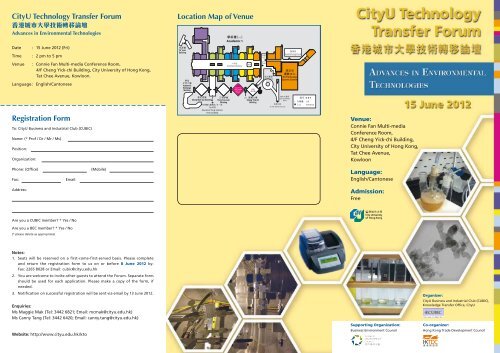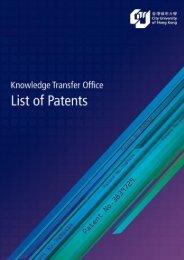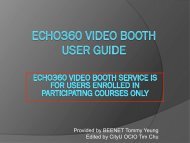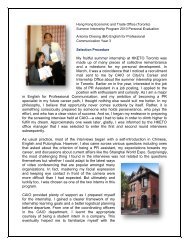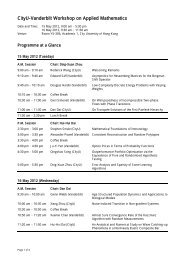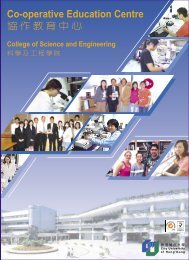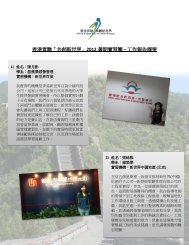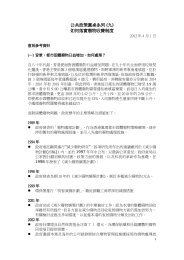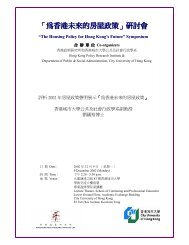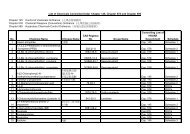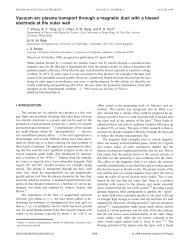Programme Leaflet - City University of Hong Kong
Programme Leaflet - City University of Hong Kong
Programme Leaflet - City University of Hong Kong
Create successful ePaper yourself
Turn your PDF publications into a flip-book with our unique Google optimized e-Paper software.
<strong>City</strong>U Technology Transfer Forum<br />
香 港 城 市 大 學 技 術 轉 移 論 壇<br />
Advances in Environmental Technologies<br />
Location Map <strong>of</strong> Venue<br />
Date<br />
Time<br />
Venue<br />
: 15 June 2012 (Fri)<br />
: 2 pm to 5 pm<br />
: Connie Fan Multi-media Conference Room,<br />
4/F Cheng Yick-chi Building, <strong>City</strong> <strong>University</strong> <strong>of</strong> <strong>Hong</strong> <strong>Kong</strong>,<br />
Tat Chee Avenue, Kowloon.<br />
Language : English/Cantonese<br />
Registration Form<br />
To: <strong>City</strong>U Business and Industrial Club (CUBIC)<br />
Name: (* Pr<strong>of</strong> / Dr / Mr / Ms)<br />
Position:<br />
Organization:<br />
Venue:<br />
Connie Fan Multi-media<br />
Conference Room,<br />
4/F Cheng Yick-chi Building,<br />
<strong>City</strong> <strong>University</strong> <strong>of</strong> <strong>Hong</strong> <strong>Kong</strong>,<br />
Tat Chee Avenue,<br />
Kowloon<br />
Phone: (Office)<br />
Fax:<br />
Email:<br />
(Mobile)<br />
Language:<br />
English/Cantonese<br />
Address:<br />
Admission:<br />
Free<br />
Are you a CUBIC member? * Yes / No<br />
Are you a BEC member? * Yes / No<br />
(* please delete as appropriate)<br />
Notes:<br />
1. Seats will be reserved on a first-come-first-served basis. Please complete<br />
and return the registration form to us on or before 8 June 2012 by:<br />
Fax: 2265 8028 or Email: cubic@cityu.edu.hk<br />
2. You are welcome to invite other guests to attend the Forum. Separate form<br />
should be used for each application. Please make a copy <strong>of</strong> the form, if<br />
needed.<br />
3. Notification on successful registration will be sent via email by 13 June 2012.<br />
Enquiries:<br />
Ms Maggie Mak (Tel: 3442 6821; Email: mcmak@cityu.edu.hk)<br />
Ms Canny Tang (Tel: 3442 6420; Email: canny.tang@cityu.edu.hk)<br />
Website: http://www.cityu.edu.hk/kto<br />
Supporting Organization:<br />
Business Environment Council<br />
Organizer:<br />
<strong>City</strong>U Business and Industrial Club (CUBIC),<br />
Knowledge Transfer Office, <strong>City</strong>U<br />
Co-organizer:<br />
<strong>Hong</strong> <strong>Kong</strong> Trade Development Council
<strong>City</strong>U Technology Transfer Forum<br />
Advances in Environmental Technologies<br />
Date: 15 June 2012 (Fri)<br />
Aim<br />
To disseminate mature technologies at <strong>City</strong> <strong>University</strong> <strong>of</strong> <strong>Hong</strong> <strong>Kong</strong> to local<br />
industry for the advancement <strong>of</strong> knowledge and technology in <strong>Hong</strong> <strong>Kong</strong>.<br />
<strong>Programme</strong><br />
Time<br />
2:00–2:25pm<br />
2:25–2:30pm<br />
2:30–3:00pm<br />
3:00–3:30pm<br />
3:30–4:00pm<br />
4:00–4:15pm<br />
4:15–5:00pm<br />
Activities<br />
Registration<br />
Welcoming remarks<br />
Presentation 1: Ozone Catalytic Oxidation (OCO)<br />
Technology for Degradation <strong>of</strong> Dye in Water<br />
Dr Oscar K S Hui, Lecturer, Department <strong>of</strong><br />
Systems Engineering and Engineering Management<br />
Presentation 2: Air Pollution Measurement and Control<br />
Technologies to Meet the Environmental Challenges<br />
Dr Zhi Ning, Assistant Pr<strong>of</strong>essor, School <strong>of</strong> Energy and<br />
Environment<br />
Presentation 3: Valorisation <strong>of</strong> C<strong>of</strong>fee Grinds and<br />
Unconsumed Bakery Waste from Starbucks <strong>Hong</strong> <strong>Kong</strong><br />
for the Sustainable Production <strong>of</strong> Chemical and Materials<br />
Dr Carol S K Lin, Visiting Assistant Pr<strong>of</strong>essor,<br />
School <strong>of</strong> Energy and Environment<br />
Q & A<br />
Networking and refreshment<br />
About the Speakers<br />
Dr Oscar K S Hui is a Lecturer at the Department<br />
<strong>of</strong> Systems Engineering & Engineering Management<br />
<strong>of</strong> <strong>City</strong> <strong>University</strong> <strong>of</strong> <strong>Hong</strong> <strong>Kong</strong>. He received his<br />
BEng degree in 2002, MPhil degree in 2004 and PhD<br />
degree in 2008 from the Department <strong>of</strong> Mechanical<br />
Engineering <strong>of</strong> <strong>Hong</strong> <strong>Kong</strong>, <strong>University</strong> <strong>of</strong> Science and<br />
Technology. Over the past 10 years, he has conducted<br />
research in different areas related to energy and<br />
environment, including Li-battery, supercapacitor,<br />
electrodes for direct methanol hydrogen peroxide fuel cell, hydrogen production<br />
by methanol steam reforming, solid-state lighting, desiccant cooling, and air and<br />
water treatment. He has managed 15 research projects as Principal Investigator<br />
with a total research grant <strong>of</strong> HKD 5.6 million. Currently, he has been collaborating<br />
with colleagues in USA, Australia, Singapore, Japan, Korea, China, and <strong>Hong</strong><br />
<strong>Kong</strong>. Thus far, his research has led to one US patent application, five Korea<br />
patent applications, 38 journal publications, and 44 conference papers.<br />
Dr Zhi Ning (PhD in Environmental Engineering,<br />
<strong>University</strong> <strong>of</strong> Southern California, USA) is currently<br />
an Assistant Pr<strong>of</strong>essor in School <strong>of</strong> Energy and<br />
Environment at <strong>City</strong> <strong>University</strong> <strong>of</strong> <strong>Hong</strong> <strong>Kong</strong>. Before<br />
joining <strong>City</strong>U, he was research assistant pr<strong>of</strong>essor<br />
in Southern California Particle Center funded by US<br />
Environmental Protection Agency. He has 10 years’<br />
experience in air pollution technologies development<br />
and aerosol related research. He has led and<br />
participated in the R&D <strong>of</strong> miniature versatile aerosol concentration system, high<br />
efficiency electrostatic precipitator, bipolar particle charger and high resolution<br />
air pollutants chemistry and toxicity sampler etc.<br />
Dr Carol S K Lin is a Visiting Assistant Pr<strong>of</strong>essor<br />
in the School <strong>of</strong> Energy and Environment at the <strong>City</strong><br />
<strong>University</strong> <strong>of</strong> <strong>Hong</strong> <strong>Kong</strong>. She graduated in Chemical<br />
and Materials Engineering from the <strong>University</strong> <strong>of</strong><br />
Auckland, New Zealand with a 1st class honours<br />
degree. Carol holds a PhD in Chemical Engineering<br />
from the <strong>University</strong> <strong>of</strong> Manchester, England. She<br />
worked as a postdoctoral researcher at the Centre <strong>of</strong><br />
Expertise — Industrial Biotechnology and Biocatalysis<br />
(InBio.be) at Ghent <strong>University</strong> in Belgium.<br />
Her current research interests focus on the valorization <strong>of</strong> food waste through<br />
conversion into commercially valuable products such as bio-degradable polymer<br />
and specialty chemicals.<br />
Synopsis<br />
Ozone Catalytic Oxidation (OCO) Technology for Degradation<br />
<strong>of</strong> Dye in Water<br />
by Dr Oscar K S Hui<br />
Coloured industrial effluents from dyeing industries represent major<br />
environmental problems because many dyes and their breakdown products are<br />
toxic to aquatic life, and are carcinogenic and mutagenic to humans. Conventional<br />
biological treatment systems are unsuitable to destroy colorants present in<br />
these waters. In the case <strong>of</strong> physical-chemical treatments such as membrane<br />
filtration, precipitation or adsorption, contaminants are only transferred from<br />
one phase to another phase without solving the global environmental problem.<br />
In this respect, OCO has become a new treatment alternative because <strong>of</strong> its<br />
high removal efficiency and low energy consumption, enabling the removal <strong>of</strong><br />
colorants from complex effluents. In this presentation, the speaker will introduce<br />
OCO technology for degradation <strong>of</strong> dye over nanoporous materials. Basic yellow<br />
87 was selected as a target basic dye pollutant owing to its low biodegradation.<br />
The proposed OCO technology <strong>of</strong>fers three striking features: i) combination <strong>of</strong><br />
adsorption, ozonation and catalytic oxidation, reducing cost and enhancing<br />
dye removal efficiency; ii) use <strong>of</strong> mesoporous material that can enhance mass<br />
transport and diffusion and increase the degradation efficiency; iii) converting<br />
dyes into carbon dioxide and water for less environment pollution and energy<br />
consumption. The OCO technology could be <strong>of</strong> value to the textile industry,<br />
providing cost effective mineralization process for the dyes in water.<br />
Air Pollution Measurement and Control Technologies to Meet<br />
the Environmental Challenges<br />
by Dr Zhi Ning<br />
With economy growth and population increase, air pollution has become one<br />
<strong>of</strong> the most serious environmental problems in mainland China as well as <strong>Hong</strong><br />
<strong>Kong</strong>. In the Twelfth Five-Year Plan (2011–2015) laid out by Chinese central<br />
government, environment protection has been listed as one <strong>of</strong> the seven strategic<br />
industries, and protecting the environment is <strong>of</strong> paramount concern as China<br />
attempts to restructure its economy to be less energy-intensive. With foreseeable<br />
implementation <strong>of</strong> more stringent air quality and emission regulations, there will<br />
be a huge market for new emission control and air pollution related technologies<br />
such as more advanced air pollution measurement, vehicle emission inspection<br />
and abatement, and pollution source control etc. This speech will present a few<br />
promising air pollution technologies to meet such a challenge.<br />
Valorisation <strong>of</strong> C<strong>of</strong>fee Grinds and Unconsumed Bakery Waste<br />
from Starbucks <strong>Hong</strong> <strong>Kong</strong> for The Sustainable Production <strong>of</strong><br />
Chemical and Materials<br />
By Dr Carol S K Lin<br />
The School <strong>of</strong> Energy and Environment at the <strong>City</strong> <strong>University</strong> <strong>of</strong> <strong>Hong</strong> <strong>Kong</strong> has<br />
recently started collaborating with c<strong>of</strong>fee retailer giant ‘Starbucks <strong>Hong</strong> <strong>Kong</strong>’.<br />
The partnership, which was facilitated by the NGO the Climate Group, will focus<br />
on the valorisation <strong>of</strong> spent c<strong>of</strong>fee grounds and unconsumed bakeries via bioprocessing.<br />
The collaboration is based on a support scheme and part <strong>of</strong> the “Care<br />
for our Planet” campaign: for every set <strong>of</strong> Care For Our Planet Cookies Charity<br />
Set sold, Starbucks will donate HK$8 to the School <strong>of</strong> Energy and Environment <strong>of</strong><br />
<strong>City</strong> <strong>University</strong> <strong>of</strong> <strong>Hong</strong> <strong>Kong</strong> to support research on valorisation <strong>of</strong> food waste<br />
for sustainable production <strong>of</strong> chemicals and materials.<br />
The aim <strong>of</strong> the research is to valorise the disposed c<strong>of</strong>fee grounds and unconsumed<br />
bakeries to bio-plastics (poly-3-hydroxybutyrate, PHB) and succinic acid. This<br />
can facilitate the development <strong>of</strong> biomass use in <strong>Hong</strong> <strong>Kong</strong> and reduce the<br />
release <strong>of</strong> greenhouse gases and other air pollutants into the atmosphere. Such<br />
a synergistic solution through the utilization <strong>of</strong> food waste for the production<br />
<strong>of</strong> value-added products can then be adopted by the <strong>Hong</strong> <strong>Kong</strong> Government<br />
as part <strong>of</strong> their strategy for tackling the food waste problem and for the<br />
environmentally friendly production <strong>of</strong> alternative platform chemicals.


